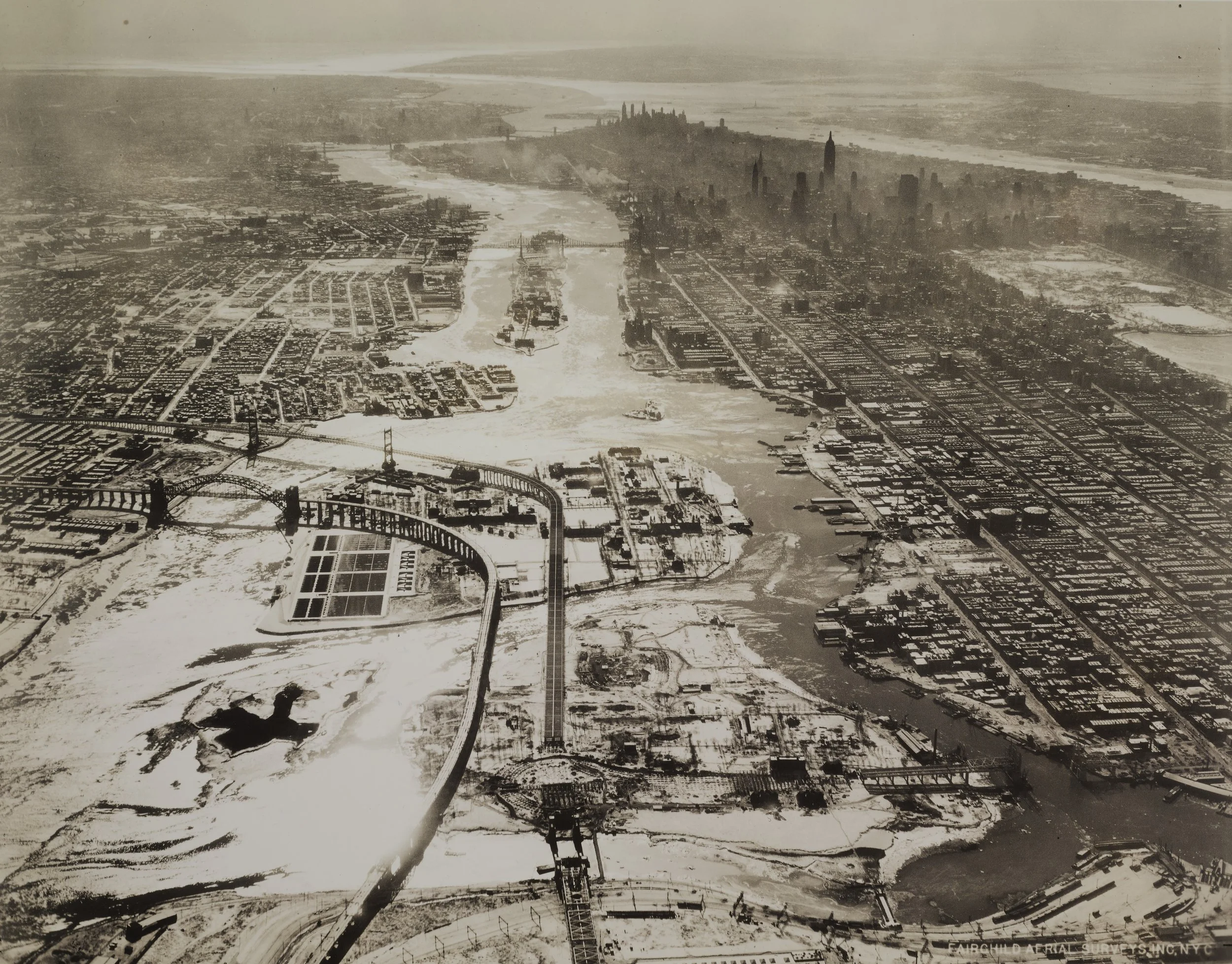Introduction
From the outset, the Triborough Bridge was proposed as a link to connect and unite a city on the brink of the modern age. The first proposal for a bridge joining Manhattan, The Bronx, and Queens, through a connection over Randall’s and Wards Islands, appeared in the 1916 New York City Department of Plant and Structures (DPS) Annual Report. At the time, the bridge was considered to be the brainchild of Edward Byrne, Chief Engineer of the Plant and Structures Department. The initial proposal focused on linking the three boroughs’ rapid transit systems, and noted, almost as an afterthought, that it would also provide vehicular and pedestrian facilities.
The planned footprint of the bridge at groundbreaking, June 30, 1930. NYC Department of Plant and Structures. Courtesy of MTA Bridges and Tunnels Special Archive.
Over the next decade, the transportation needs of the City changed substantially. The vision for a bridge connecting the boroughs adapted as well, and the Department no longer saw it as an integral link in a mass transit chain but, instead, as part of a system that would include the planned George Washington Bridge and upgrades to the Queensboro Bridge.
Bird’s eye view showing the future site of the Triborough Bridge. Curtiss-Wright Flying Service-Photo Division. October 24, 1931. Municipal Archives, City of New York.
By 1929, planning evolved into action. Mayor James Walker held groundbreaking ceremonies for the bridge in Astoria Park on October 25, 1929. The Department of Plant and Structures proceeded with construction until 1932, when anchorages were completed. By that time, the Great Depression reduced City funding available for the bridge. Instead of committing additional municipal funds, efforts focused on the New York State Emergency Public Works Commission, chaired by Robert Moses, which asked the federal Reconstruction Finance Corporation for funding.
In 1933, the New York State Legislature authorized formation of the Triborough Bridge Authority. The independent authority applied for funding through the newly formed Public Works Administration. Byrne was named the Chief Engineer of the Authority. In 1934, incoming Mayor Fiorello LaGuardia ordered a “clean sweep” of the authority’s leadership. Othmar Ammann, Chief Engineer of the Port of New York Authority replaced Byrne. The General Manager and General Counsel resigned and were replaced, and Moses joined the Authority as secretary.
View showing the entire model of the Triborough Bridge and its environs. The model is probably shown here displayed at the Triborough Bridge Authority’s Randall’s Island headquarters, circa 1938. Photographer unknown. Courtesy of MTA Bridges and Tunnels Special Archive.
Ammann promptly began redesigning the bridge to achieve cost savings that would allow for its completion within the $37,000,000 provided by the Public Works Administration. Eight lanes became two, granite cladding was stripped from the design and approach roads were laid out which would truly unite the three boroughs. Work continued at a frantic pace, on the bridge and on the development of Randall’s and Wards Islands’ recreation facilities. Officials were so confident in their schedule that they planned the opening of Randall’s Island Stadium, and the Olympic Track and Field tryouts, for the same day.
View of the traffic junction on Randall’s Island, looking towards generating stations in Queens, circa 1937. Richard Averill Smith. Courtesy of MTA Bridges and Tunnels Special Archive.
The Triborough Bridge opened on July 11, 1936 marking the unification of three boroughs, an achievement for New York both technologically and socially. President Franklin D. Roosevelt spoke at the opening of both the bridge and the stadium, demonstrating its importance on both regional and national maps. The bridge continued to be operated by the Triborough Bridge Authority.
Recreatonal facilities on Wards Island, 1965. Photographer unknown. Courtesy of MTA Bridges and Tunnels Special Archive.
The bridge ushered in changes in each of the boroughs. For Manhattan, the development of Randall’s and Wards Island (later joined through fill into a single entity) expanded access to parks and recreational facilities. Institutional centers, such as the House of Refuge, were shuttered and torn down, and their residents dispersed. Queens retained its rural charm into the 20th century. It became the gateway to Long Island, which was being developed as both a residential and recreational center, and was also an agricultural center. The Bronx became a powerhouse of transportation, connecting Long Island and Manhattan with the mainland.
Workers paint the suspender cables of the Queens span, April 1, 1936. Photographer unknown. Courtesy of MTA Bridges and Tunnels Special Archive.





